Partial knee replacement surgery
Knee replacement is the final treatment available on the ladder of therapies for knee arthritis. The majority of people needing replacement surgery will need a total knee replacement. Some people will, however, have arthritis affecting only one of the three main parts of the knee and may benefit from a partial knee replacement
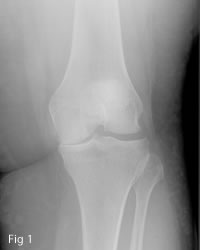
The medial compartment
The inner half of the joint between the thigh bone (femur) and shin bone (tibia) is called the medial compartment.
Approximately one third of people with knee osteoarthritis (OA) will have it only in the medial compartment.
What are the symptoms?
The symptoms will be very similar to those in people with arthritis throughout the joint. Pain, stiffness and progressive deformity are the features. There may well be a pre-existing bow-legged deformity which predisposes to medial compartment arthritis as all the load passes through the inner half of the knee.
Fig 1 Medial compartment OA
What are the options?
Once the stage has been reached where knee replacement is to be considered, the options are either total knee replacement or a unicompartmental (partial) knee replacement. For a partial knee replacement, the deformity must be correctable, the ligaments must all be intact and the range of knee movement should be preserved.
Why partial knee replacement?
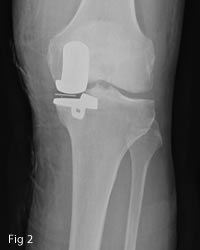
There are a number of advantages of partial knee replacement over total knee replacement. The major benefit is that the knee ligaments are all spared by the surgery. This allows normal knee movement and a normal feeling knee. In addition the operation is carried out with a small incision and less trauma. Should the replacement need changing in the future this is reasonably straight forward. On the downside, the rest of the knee could develop arthritis and the operation is a little more difficult than total knee replacement. In general partial knee replacements should only be done in hospitals carrying out reasonable numbers.
Fig 2 Medial unicompartmental replacement
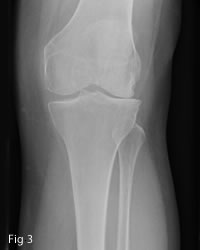
The lateral compartment and its symptoms
Around 5% of people with knee arthritis will have it confined to the outer half of the knee joint. This type of OA is unusual in many ways. It usually affects the knee when in a bent rather than straight position and is often therefore missed by clinicians and X-rays. It often causes a feeling of instability or giving out, rather than pain, and is commonly the result of a previous cartilage operation.
Fig 3 Lateral compartment OA
Lateral compartment options?
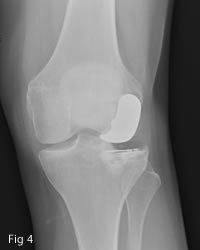
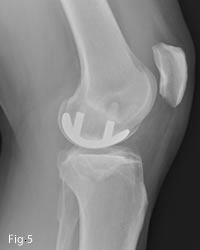
As with medial compartment disease, a partial or total knee replacement may be appropriate. The decision should be made between the surgeon and patient with the relevant "pro'’'s and con'’'s" discussed. Lateral compartment replacement is only performed in a few specialist research units.
Figs 4 & 5 Lateral unicompartmental replacement
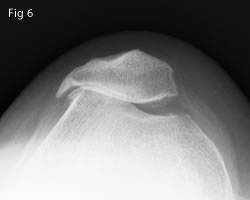
The patellofemoral compartment
The joint between the kneecap (patella) and the femur is called the patellofemoral joint. It allows the forces of the thigh muscles (quadriceps) to be transmitted to the tibia over the patella. This joint is subjected to extremely high forces and is vulnerable to instability for a number of reasons. As a result about 5-10% of people with OA will have it only in this compartment.
Fig 6 Patellofemoral OA
What are the symptoms?
People with patellofemoral OA will characteristically complain of pain. The pain may be felt at the front but also, often, the back of the knee. Pain is felt more on hills and stairs and is easier on level ground. Typically driving and sitting for long periods is difficult. Occasionally a feeling of instability or untrustworthiness is prominent. There may be a history in the past of patella dislocation. Swelling is rarely a feature.
What are the options?
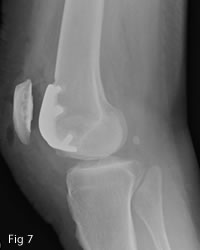
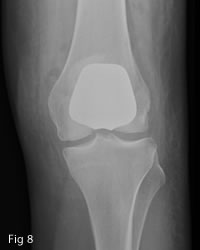
Once the decision has been made to proceed with replacement surgery, the options of total or patellofemoral replacement can be considered. Half of patients with patellofemoral arthritis will be below the age of 60. The advantages and disadvantages of partial knee replacement are the same for all three compartments, and the final decision will rest with the patient.
Figs 7 & 8 Patellofemoral replacement
The future
Due to the potential benefits of preserving all the ligaments and allowing normal knee movement, research is focusing on the possibility of combining partial knee replacements to treat arthritis affecting more than one compartment. Development is at an early stage and this surgery is certainly not widely available.
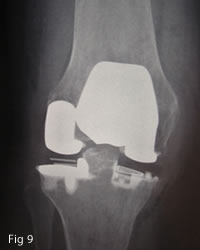
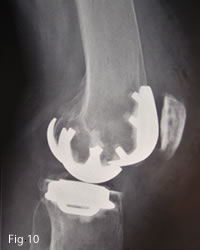
Bristol
Contact us on
0117 980 4037
or
0117 980 4046

